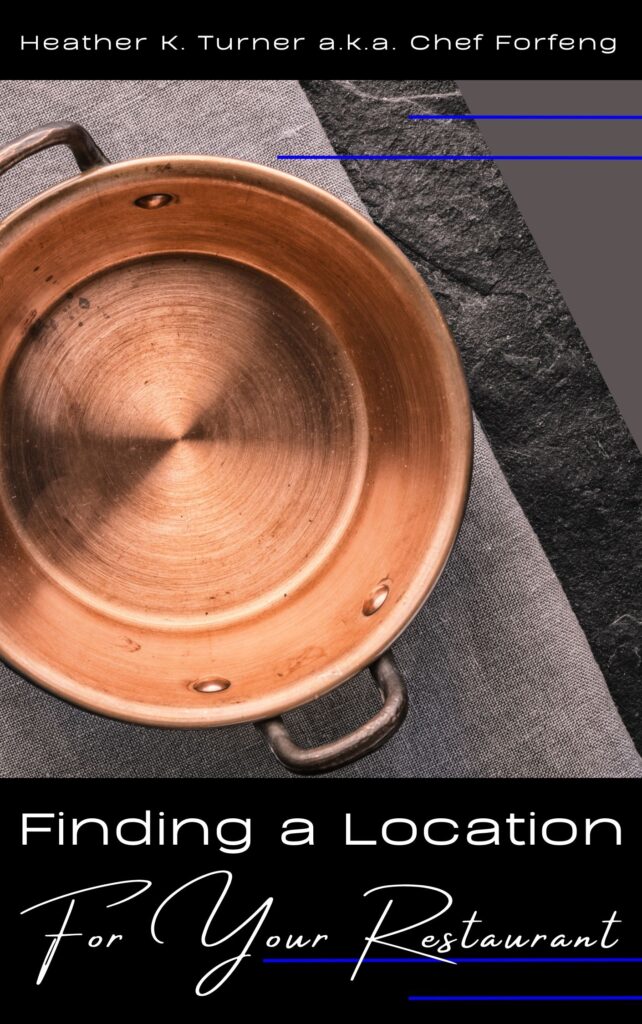by Heather T. | Oct 23, 2020 | Food, Marketing, Operations, restaurants

Not a working QR code, just an example
This past Monday I ran a workshop session for my SCORE chapter, Restaurants, Mastering the Art of Takeout. One of the topics I touched on was QR codes and how restaurants and other foodservice establishments could leverage use QR codes in conjunction with Google Docs to be creative with their menus as well as offer things like reheating instructions for takeout to customers without having to add a printed piece of paper to the takeout order. I had written a blog post touching briefly on this topic last month, Tackling Some of the Challenges of Takeout Food for Restaurants.
Before I dive into some of the uses, there are somethings I want to touch on first. This is something I have been discussing with many of my own business clients for months.
If you are not familiar with Google Docs, it’s Google’s free online alternative to Microsoft office, there are also Google Sheets (like Excel), Google Slides (like Powerpoint), and quite a few more applications. I like using the online applications because you can share with anyone, share editing capability with anyone, access it from anywhere, and unlike desktop-based programs, which even if autosave is turned out, you may lose content if you have a power outage or other computer issue. When you add something in a Google Doc, it’s still there even if you get booted off the internet or you go offline for other reasons.
If you are looking for help with the Google applications, Google itself has a lot of resources, https://support.google.com/a/users/answer/9282664?hl=en and https://support.google.com/docs/?hl=en#topic=1382883 have some great tutorials. There are also some very helpful tutorial/help documents at https://edu.gcfglobal.org/en/googledocuments/.
If you are not overly familiar with QR Codes, this might also be useful. I am glad to see the resurgence of them because they had so many practical applications and were also often misused but that’s a topic for another blog, but if you want a laugh, this is probably my favorite UnMarketing video featuring Marketing Guru (and I don’t apply the term Guru lightly to anyone) Scott Stratten, QR Codes Kill Kittens. It looks like a session he did at one of the conferences he speaks at but sadly it doesn’t say which it. Scott is also one of my favorite people to follow on Twitter.
Before you create your first QR code, read the difference between both, and make sure you read the fine print before you set up and start using them in your business. I bring this up because many Dynamic QR Code creation platforms offer it as “free” but it’s not really, it’s a free trial or they don’t actually point out that heaven forbid you actually want to edit/change any links after you’ve created them…….you have to pay for them.
Static QR Code: A Static QR Code contains information that is fixed and un-editable once the Code has been generated.
Dynamic QR Code: Dynamic QR Codes allow you to update, edit, and change the type of the QR Code however many times you need, which makes them the best fit for restaurants and marketing purposes.
Back to the topic at hand ?
With many menus now only being hosted solely online and traffic driven to them in-house from QR codes or having to do daily printed menus for safety reasons, having an easily editable and also (and this is important) mobile-friendly version of your website is key. While you can tie your menus into online ordering if you want people to call or email or message you to make a takeout order instead of ordering through an app or website, being able to easily edit and change your menus becomes a higher priority, especially if you employ a web designer to maintain your website and who would charge you every time you wanted to make a menu change. While you can upload a photo or image of the menu daily or embed a word doc or other type of document, while it may look great on a desktop or laptop, it’s not generally mobile-friendly.
I bring this up because I’m seeing a lot of this recently. A mobile-friendly website with an image in it (the menu) that is too small to read on mobile because it doesn’t resize. Example one below, example two (Below that) is what a Google Doc looks like on mobile.
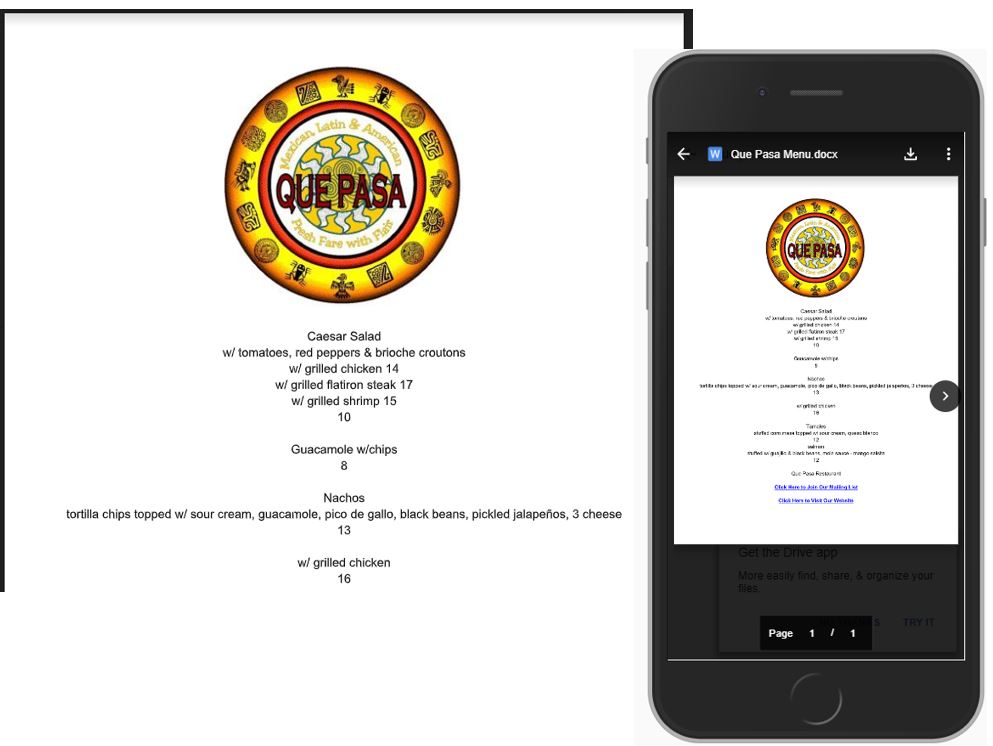
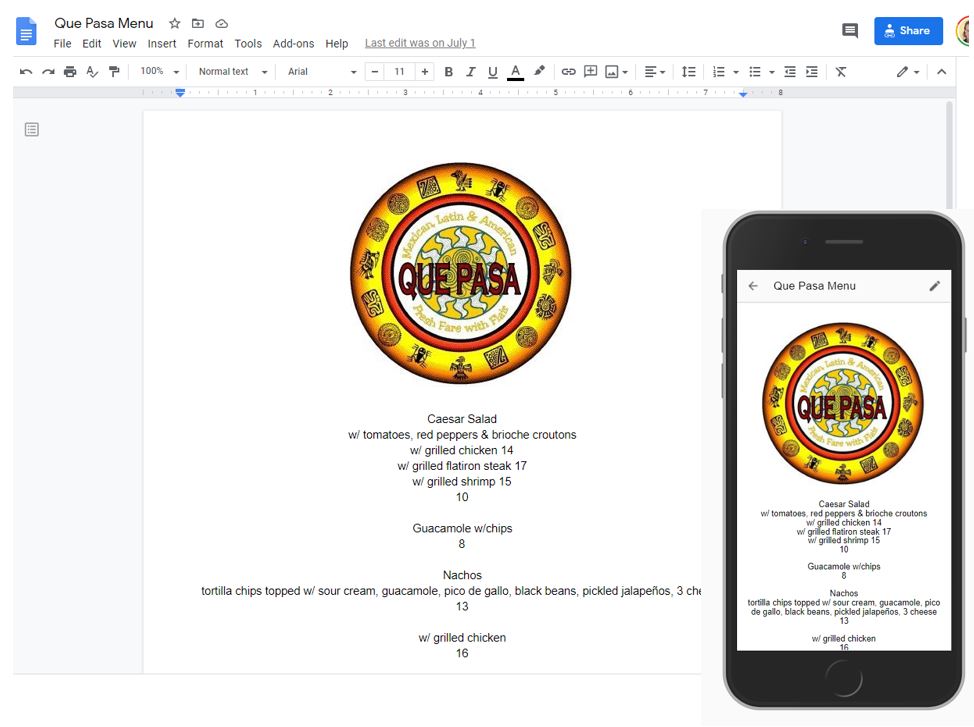
Even if you don’t want to use Google Docs for the above reason, it is something to think about if you are giving people heating or re-heating instructions for items, think about doing a Google Doc for menu items and doing a QR code with a link to the online instructions to reheat them. These QR codes can be easily printed off using an in-house printer and Avery labels and stuck onto the outgoing takeout containers. Whether you do one document that has general heating instructions for all, one that has individual heating instructions for everything that could be reheated on the menu (remember this is extremely easy to change the information online and an update is instantaneous) or customized documents for each with different QR codes is up to you. The QR code on the below sample actually works, any links to my Twitter account, come on over and say hello!
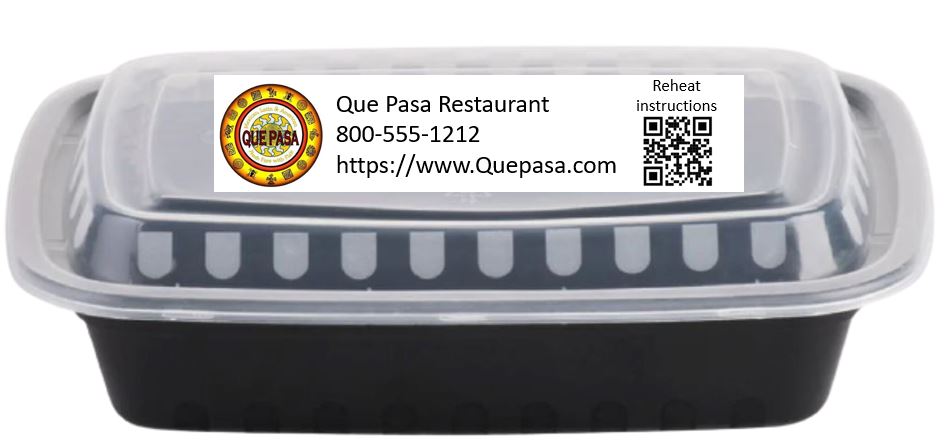
In a few weeks, I’ll be doing a follow-up Webinar for SCORE (these are free so I encourage people to take advantage of both SCORE national and regional/state offerings as they come up.)
by Heather T. | Sep 22, 2020 | Food, Marketing, Operations, restaurants
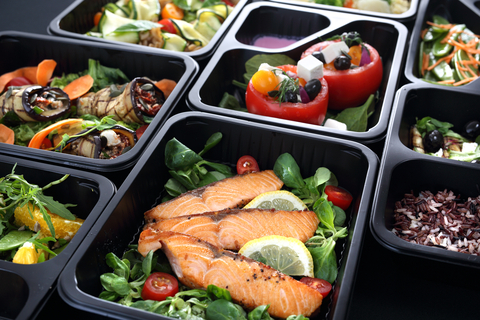 For at least the foreseeable future takeout is probably here to stay for a bit. Love it or hate it as a restaurant owner, having to accept the fact that it is a viable revenue stream is still tough for a lot of owners and managers to adjust to, especially for fine dining restaurants. But as the colder weather approaches it bears a lot of thought to re-address all aspects of takeout.
For at least the foreseeable future takeout is probably here to stay for a bit. Love it or hate it as a restaurant owner, having to accept the fact that it is a viable revenue stream is still tough for a lot of owners and managers to adjust to, especially for fine dining restaurants. But as the colder weather approaches it bears a lot of thought to re-address all aspects of takeout.
I’ve seen many restaurants trying to offer the same menus for in-person dining repurposed to do as takeout, unfortunately for many restaurants, that can be a fatal flaw. Not every menu item adjusts to the takeout scene well, in many cases, reheating it causes overcooking, dryness, or in the case of many fried or sauteed items (like a chicken Marsala with a chicken breast that has been egg and flour dipped and then sauced right before serving) ends up being soggy in transit and may not lend well to reheating.
I’ll be addressing doing a deep dive on the menu itself in the next blog but wanted to address some things regarding takeout containers first.
Questions to ask:
Does it reheat well? And specifically, have you as the Chef or management/owners tried to reheat it in a variety of ways? To take the chicken Marsala as a good example, microwaving the chicken will probably kill it (unless you like rubber chickens), and nuking the sauce will probably break it. Heavy cream doesn’t generally play nice with microwaves. A perfect reheat would probably be the chicken heated up separately in a hot oven with the sauce separate and reheated with the mushrooms in a saucepan and the sauce packed to go separately.
So…Do your customers know how to reheat your food? And if not, how would they know? And if you don’t want to bother considering that, is a rubber chicken with broken sauce doing your restaurant any favors as an example? The number of reviews I have seen since Covid hit mentioning that people were not very happy with their take out for restaurants with normally good to great reviews has not decreased much so it’s still apparently a big problem.
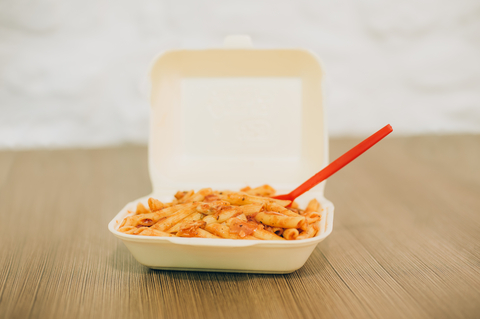 Next, Is it going to look attractive in the container? While some restaurants may not have the style of dining that plate presentation is high on the priority list, if you have a fine dining restaurant (for example) and you take pride in that, it is a consideration. While I have worked a variety of types of restaurants no matter the level of dining, plate presentation was always important to me, but in some cases, a takeout burger and waffle fries may not have a ton of ways to dress it up but even that can either look attractive when unboxed (or not). I am seeing a huge amount of takeout photos on Instagram and Facebook, so the love affair with taking food photos has not dimmed much. Does this container of pasta look ok? Or could a little garnish improve it? Not sure? Take a few photos with your smart phone yourself? Does it look attractive? Appealing? If you saw it posted on Instagram, would it make you want to get take out from your restaurant?
Next, Is it going to look attractive in the container? While some restaurants may not have the style of dining that plate presentation is high on the priority list, if you have a fine dining restaurant (for example) and you take pride in that, it is a consideration. While I have worked a variety of types of restaurants no matter the level of dining, plate presentation was always important to me, but in some cases, a takeout burger and waffle fries may not have a ton of ways to dress it up but even that can either look attractive when unboxed (or not). I am seeing a huge amount of takeout photos on Instagram and Facebook, so the love affair with taking food photos has not dimmed much. Does this container of pasta look ok? Or could a little garnish improve it? Not sure? Take a few photos with your smart phone yourself? Does it look attractive? Appealing? If you saw it posted on Instagram, would it make you want to get take out from your restaurant?
Are there reheating instructions? A medium-rare steak will not be MR when reheated improperly, does that reflect on the restaurant if customers overcook a dish at home? I would say yes because you can’t expect people to know.
Can customers reheat a dish directly in the container or does it need to be transferred? Is it easy to transfer? Is it messy? Do you loose sauce or ingredients in transferring?
Is the takeout container reusable? To use an example of why that may be a consideration: when we lived in CT, there were two oriental restaurants with similar pricing and fairly comparable food. We ordered from one because A. the containers were not flimsy, the other ones were and we gave up ordering food from them when we had a mess to clean up at home almost every time, and B. the containers were washable and reusable.
Is the takeout container cheap and flimsy? (see above) If you want to go for non-reusable/non-recyclable containers, is the container going to stand up to travel, being lifted out of a bag, and held with one hand (or will it take two and fold over spilling everything everywhere?). We have gotten take out from restaurants who use the round oval aluminum take out containers which while they are fine for light food like salads, load them up with a heavy entrée with sauce and the result can be a mess on the customers end. They might remember the food was good but they will also remember the hassle and inconvenience.
Does the container retain heat well? or remain cold? If I order takeout from a restaurant minutes away I expect the food to remain hot until I get home. And is it protected from anything that is not hot? Is there a layer of cardboard or another item in between. Is your staff giving attention to packing up take out so salads don’t end up directly above or below a hot item? Or cold desserts getting melted by being close to a hot item? Yum wilted warm salad. Delish!
Having a variety of containers on hand for different types of items are highly suggested. And add the price of takeout to your menus, it may only be 15-20 cents per but it can add up very fast if you don’t factor it in and it appears looking at a lot of menus from pre-Covid and current, many restaurants are not. It’s a small adjustment but worth it.
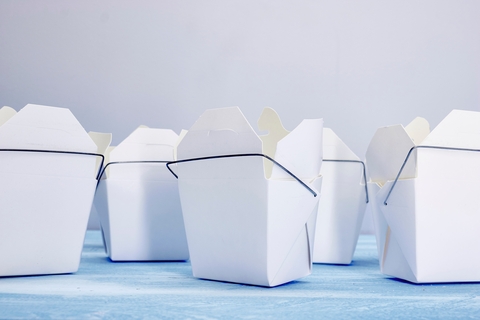 Consider the Chinese takeout container, high sides, fairly heavy-duty, and well designed, there is a reason this design has been in use for a very long time. It also stacks well and that is an additional factor to think about when evaluating your takeout containers. I’m not saying every restaurant should use these, but merely to consider things that need to factor in choosing containers. Stackability, structure, and compact fit in a bag vs rounds or an assortment of different shaped oblongs. The vast variety of takeout containers available on the market offers a plethora of options, find what works for you instead of purely going by price or looks. The final result is the important part and again if a decent container that fits the bill is 5 cents more then the cheap round, buy it and add it to the menu price, your customers will thank you.
Consider the Chinese takeout container, high sides, fairly heavy-duty, and well designed, there is a reason this design has been in use for a very long time. It also stacks well and that is an additional factor to think about when evaluating your takeout containers. I’m not saying every restaurant should use these, but merely to consider things that need to factor in choosing containers. Stackability, structure, and compact fit in a bag vs rounds or an assortment of different shaped oblongs. The vast variety of takeout containers available on the market offers a plethora of options, find what works for you instead of purely going by price or looks. The final result is the important part and again if a decent container that fits the bill is 5 cents more then the cheap round, buy it and add it to the menu price, your customers will thank you.
by Heather T. | Apr 11, 2019 | Bed and Breakfasts, Food
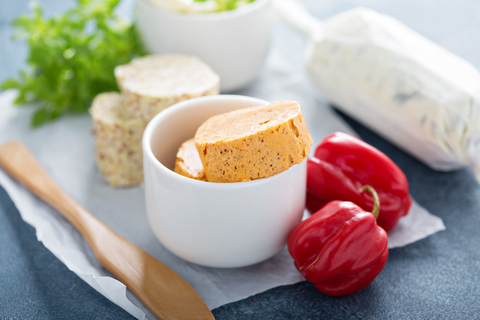
This past January one of the sessions I ran was “In the Kitchen Time Savers”, and I had a slide about compound butters. Interestingly enough, most of the questions I got at the tail end of the session were asking about the butters, I had innkeepers tracking me down after the session to ask about them and innkeepers are still emailing me, the one this morning actually is the one that prompted me to write this up.
What I have been asked about primarily is some suggestions and any tips and tricks I’ve learned over the years. So here goes……
Realistically almost anything can be made into a compound butter, aside from the usual types, you can add finely chopped smoked bacon or diced smoked salmon, lobster butter is also quite lovely, especially on top of a nice omelet or poached egg, also quite good on savory waffles as well. Smoked salmon and dill butter on a sweet potato pancake or waffle is a tasty combination. Method, soften the butter, throw into a mixer, whip, add ingredients, roll into logs, refrigerate and serve.
Using a hot knife to cut the logs is suggested (running under hot water or having a bain marie filled with hot water if you are going to cut a bunch makes it much easier to cut) be sure to wipe the blade down to remove any water first. There are cheese and butter cutters with waffle cuts that can make some fun patterns as well when cutting.
The sky and your imagination are all that hold you back. The one rule of thumb is if something tastes good with butter on it (the exception being a steak, I have tried making a compound butter with it, and it’s “interesting”) it’s generally going to taste good as a compound butter mix.
When in doubt, try micro batches. I prefer using my KitchenAid Mixer to make compounds, but if experimenting, I would use a regular small bowl and spatula to test and just do a tablespoon at a time.
Use unsalted butter to start, add Kosher Salt to taste, I prefer Diamond brand Kosher salt as other Koshers tend to be saltier and textured differently. Even with fruit butter, a pinch of salt brings the flavors out. Using iodized salt in compound butter is just gross, sorry, but it is.
While you can use plastic wrap to make the butter logs, I prefer parchment paper as it makes a more even roll, wrap well in plastic wrap after to ward off refrigerator or freezer odors.
You can set the compound butter in a large square or oval dish and use a butter curler to make individual curls as well, just be sure that any compound butters you are using with a butter curler are smooth, chunky butters like nut or chopped fruit will not curl well. I have also cut out shapes with a cookie cutter, like hearts and stars and reused the leftover butter bits for something else.
Compound butters can be cut from the log and served on a plate as an accompaniment, put in small ramekins to serve or placed directly on your entree or side, they are so versatile and I always found it fun to watch a guest in a dining room ohh and ahh over a lovely roasted pepper compound butter strategically placed on top of their stuffed sole melting slowly down over it. Where oh where was Instagram 20+ years ago?
Toasting any spices in a cast iron past before use (cool down before adding to the butter mix) brings out most flavors.
Fresh Herbs are always the way to go when making compound butters, dried herbs, even if rehydrated, never have the same flavor and the color is not a poppy as well.
I also recommend using fresh garlic and ginger, while powdered does work as well, you will get a better flavor from using fresh ingredients. If you are using a recipe, even one you have developed, taste the garlic or ginger first before adding, I suggest this about most herbs as well. One head of garlic can have a hugely different flavor from another head, that one tablespoon of chopped garlic per one pound of butter may be perfect one time, but overwhelm or underwhelm the next.
If using alcohol or liquors for the compound butters, burning off the alcohol in advance is best, let cool before adding to the mix.
If putting citrus in butters, don’t just use the juice, cut out the supremes (the segments) and chop up and use as well. Tip; using canned mandarin oranges (drain well first) makes excellent citrus butters.
For using other fruits and nuts in butter, puree or finely chop in a food processor before adding them to the whipped butter.
I try to keep most compound butters less then a week, the shelf life will vary depending on the ingredients, if you are making large batches, I’d suggest freezing them (very well wrapped to negate odors) for less than two months. Optimally a month is best. I have kept compound butters In the freezer longer with no ill effects, but again it depends on the ingredients used.
Making homemade butter is always a treat to use as a compound. Because compound butters usually don’t keep for long, the normal shelf life of homemade butter (2-3 weeks) generally doesn’t come into play. I personally love Kate’s Homemade Butter, which I think is one of the best butters out there, I prefer it above even Plugra. Please use a good butter, even if a little more expensive, the flavor makes a difference and guests notice, good ingredients are so important. It’s like cooking with cheap wine, your sauce will taste a million times better if you buy that $13.00 bottle of 19 Crimes Red Blend and use half and drink half vs the $6 cooking wine. It doesn’t have to break the bank just up the game a little.
Keep in mind when making compounds you want to think of the end results and what you intend to do with them, are they to compliment a dish you make frequently? Is it to go on every table daily to accompany muffins that may change flavor daily or scones? Experimenting is fun, but think about when you batch compound butters, is this something you are going to end up with a lot extra of, and even if frozen will it languish in the freezer until you have to throw it out to make room for something else?
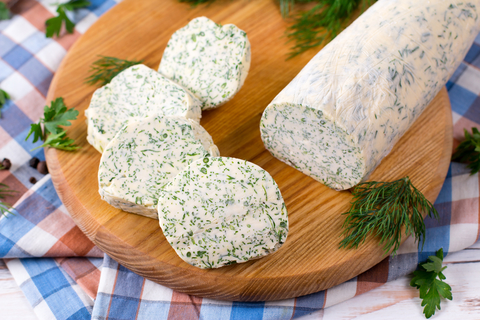
These are some of my favorites I’ve made over the years:
Sweet Butters
• Dried Blueberry and Lavender Butter
• Honey Grand Marnier Butter (also good with Toasted Walnuts or Pecans)
• Toasted Pecan and Maple Butter
• Orange Honey Butter
• Ginger and Grapefruit Butter
• Chocolate and Black Pepper Butter
• Dark Chocolate and Toasted Hazelnut Butter
• Blackberry and Sage Butter
• Mango and Ginger Butter (Mango puree works the best for this).
• Dried Cherry and Bourbon Butter
• Strawberry and Toasted Walnut Butter
• Raspberry and Chocolate Mint Butter
• Banana and Cumin Butter (with a touch of honey)
• Cinnamon Maple Butter
• Blueberry and Cardamom Butter
Sweet or Savory
• Reduced Balsamic Butter (or you can cheat and use something like Blaze’s Reduced Balsamic)
• Chocolate Balsamic Butter
• Mexican Chocolate and Chili Butter
• Honey Sriracha Butter
• Red Wine or Port Butter (always reduce the wine or port to a ¼ of its original for the best flavor, I like using Port better as it has a somewhat sweeter final taste, also yummy with some dark cocoa power dashed in)
• Blood Orange and Ginger Butter
• Macha Tea and Ginger Butter
• Roasted Apricot and Thyme Butter
• Pink Peppercorn and Grapefruit Butter
• Roasted (or Grilled) Pear and Agave Butter (Puree the pears in advance or chop very finely)
• Blueberry and Thyme Butter
• Roasted Peach and Mint Butter
• Poppyseed and Lemon Butter
• Fig and Honey Butter
Savory Butters
• Garlic and (any herb) Butter
• Lime and Cilantro Butter
• Honey Mustard and Dill Butter
• Roasted Cerignola Olive and Rosemary Butter
• Chipotle and Smoked Paprika Butter
• Jalapeno, Lime and Cilantro butter
• Lemon and Dill Butter
• Chive and Whole Grain Mustard Butter
• Caramelized Onion or Shallot Butter with Cracked Peppercorns (Peppercorn Melange/Mixed Peppercorns are good in this)
• Gooseberry and Ponzu Butter
• Grilled Eggplant and Basil Butter
• Caper and Tarragon Butter
• Roasted Pepper Butter (Red bells will give you a different flavor and color then yellows and oranges)
• Soy Sauce and Lime Butter (I like Citrus Ponzu, Lime and Ginger Butter as well)
• Smoked Tomato and Garlic Butter
• Roasted garlic (and any herb) Butter
• Black Garlic and Rosemary Butter
• Toasted Sesame and Lime Butter
• Kalamata and garlic butter (I like roasting the olives first as it gives an additional dimension to the flavor.
I could go on as there are hundreds, nay thousands of combinations out there, use your imagination and have fun!





 For at least the foreseeable future takeout is probably here to stay for a bit. Love it or hate it as a restaurant owner, having to accept the fact that it is a viable revenue stream is still tough for a lot of owners and managers to adjust to, especially for fine dining restaurants. But as the colder weather approaches it bears a lot of thought to re-address all aspects of takeout.
For at least the foreseeable future takeout is probably here to stay for a bit. Love it or hate it as a restaurant owner, having to accept the fact that it is a viable revenue stream is still tough for a lot of owners and managers to adjust to, especially for fine dining restaurants. But as the colder weather approaches it bears a lot of thought to re-address all aspects of takeout. Next, Is it going to look attractive in the container? While some restaurants may not have the style of dining that plate presentation is high on the priority list, if you have a fine dining restaurant (for example) and you take pride in that, it is a consideration. While I have worked a variety of types of restaurants no matter the level of dining, plate presentation was always important to me, but in some cases, a takeout burger and waffle fries may not have a ton of ways to dress it up but even that can either look attractive when unboxed (or not). I am seeing a huge amount of takeout photos on Instagram and Facebook, so the love affair with taking food photos has not dimmed much. Does this container of pasta look ok? Or could a little garnish improve it? Not sure? Take a few photos with your smart phone yourself? Does it look attractive? Appealing? If you saw it posted on Instagram, would it make you want to get take out from your restaurant?
Next, Is it going to look attractive in the container? While some restaurants may not have the style of dining that plate presentation is high on the priority list, if you have a fine dining restaurant (for example) and you take pride in that, it is a consideration. While I have worked a variety of types of restaurants no matter the level of dining, plate presentation was always important to me, but in some cases, a takeout burger and waffle fries may not have a ton of ways to dress it up but even that can either look attractive when unboxed (or not). I am seeing a huge amount of takeout photos on Instagram and Facebook, so the love affair with taking food photos has not dimmed much. Does this container of pasta look ok? Or could a little garnish improve it? Not sure? Take a few photos with your smart phone yourself? Does it look attractive? Appealing? If you saw it posted on Instagram, would it make you want to get take out from your restaurant?  Consider the Chinese takeout container, high sides, fairly heavy-duty, and well designed, there is a reason this design has been in use for a very long time. It also stacks well and that is an additional factor to think about when evaluating your takeout containers. I’m not saying every restaurant should use these, but merely to consider things that need to factor in choosing containers. Stackability, structure, and compact fit in a bag vs rounds or an assortment of different shaped oblongs. The vast variety of takeout containers available on the market offers a plethora of options, find what works for you instead of purely going by price or looks. The final result is the important part and again if a decent container that fits the bill is 5 cents more then the cheap round, buy it and add it to the menu price, your customers will thank you.
Consider the Chinese takeout container, high sides, fairly heavy-duty, and well designed, there is a reason this design has been in use for a very long time. It also stacks well and that is an additional factor to think about when evaluating your takeout containers. I’m not saying every restaurant should use these, but merely to consider things that need to factor in choosing containers. Stackability, structure, and compact fit in a bag vs rounds or an assortment of different shaped oblongs. The vast variety of takeout containers available on the market offers a plethora of options, find what works for you instead of purely going by price or looks. The final result is the important part and again if a decent container that fits the bill is 5 cents more then the cheap round, buy it and add it to the menu price, your customers will thank you.


